Deza M.M., Laurent M. Geometry of Cuts and Metrics
Подождите немного. Документ загружается.

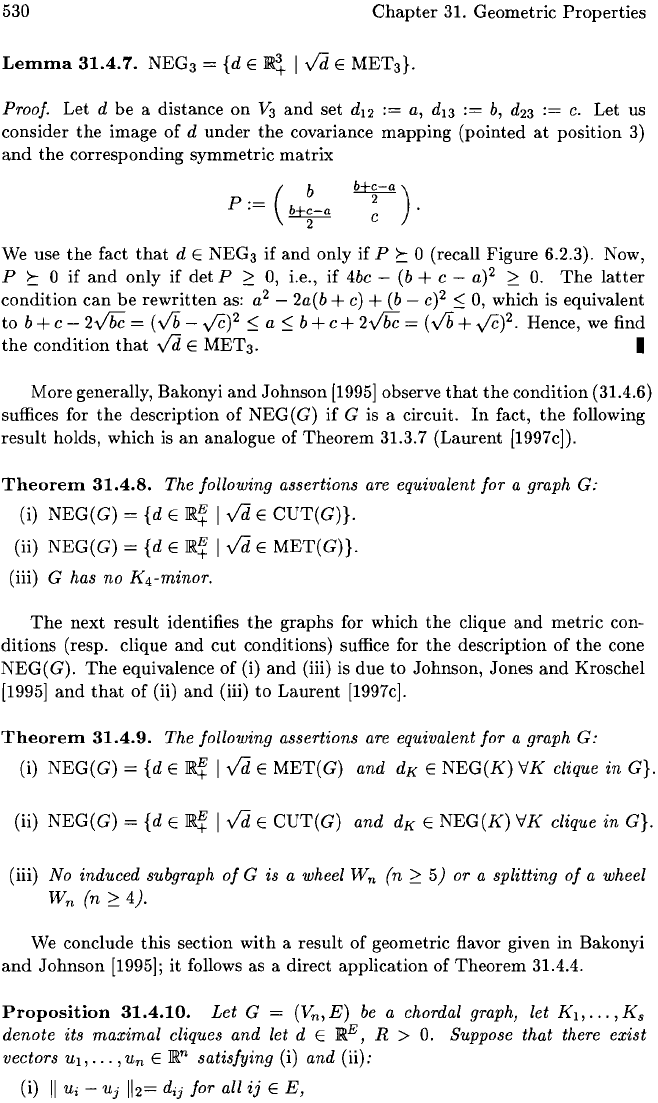
530
Chapter
31. Geometric
Properties
Lemma
31.4.7.
NEG
3
=
{d
E
~~
I
Vd
E MET3}.
Proof. Let d be a distance
on
V3
and
set
d12
:=
a,
d13
:=
b,
d
2
3
:=
c.
Let us
consider
the
image
of
d
under
the
covariance
mapping
(pointed
at
position
3)
and
the
corresponding
symmetric
matrix
(
b
btc
c2
-a)
.
P:=
bt~-a
We use
the
fact
that
dE
NEG
3
if
and
only if P
~
° (recall Figure 6.2.3). Now,
P
~
° if
and
only if det P
2:
0, i.e., if 4bc -
(b
+ c - a)2
2:
0.
The
latter
condition
can
be
rewritten
as: a
2
-
2a(b +
c)
+
(b
-
c)2
~
0, which is equivalent
to
b + c -
2VbC
=
(Vb
- .jC)2
~
a
~
b + c +
2VbC
=
(Vb
+ .jC)2. Hence,
we
find
the
condition
that
Vd
E MET3. I
More generally, Bakonyi
and
Johnson
[1995]
observe
that
the
condition (31.4.6)
suffices for
the
description
of
NEG (G)
if
G is a circuit.
In
fact,
the
following
result
holds, which
is
an
analogue of
Theorem
31.3.7 (Laurent [1997c]).
Theorem
31.4.8.
The following assertions are equivalent
for
a graph
G:
(i) NEG (G) = {d E
~~
I
Vd
E
CUT(G)}.
(ii) NEG (G) = {d E
~~
I
Vd
E
MET(G)}.
(iii) G has
no
K
4
-minor.
The
next
result
identifies
the
graphs
for which
the
clique
and
metric
con-
ditions (resp. clique
and
cut
conditions) suffice for
the
description
of
the
cone
NEG(G).
The
equivalence
of
(i)
and
(iii) is
due
to Johnson, Jones
and
Kroschel
[1995]
and
that
of
(ii)
and
(iii)
to
Laurent
[1997c].
Theorem
31.4.9.
The
following assertions are equivalent
for
a graph
G:
(i)
NEG
(G)
=
{d
E
~
I
Vd
E
MET(G)
and
dK E
NEG(K)
VK
clique
in
G}.
(ii) NEG
(G)
=
{d
E
~~
I
Vd
E
CUT(G)
and
dK E
NEG(K)
VK
clique
in
G}.
(iii)
No
induced subgraph
of
G is a wheel Wn (n
2:
5) or a splitting
of
a wheel
Wn
(n
2:
4).
We conclude
this
section
with
a result
of
geometric flavor given
in
Bakonyi
and
Johnson
[1995]; it follows as a direct application of
Theorem
31.4.4.
Proposition
31.4.10.
Let
G = (Vn'
E)
be
a chordal graph, let K
1
, •
..
,Ks
denote
its
maximal
cliques
and
let d E
~E,
R >
0.
Suppose
that
there
exist
vectors
Ul,
...
,Un
E
~n
satisfying
(i)
and
(ii):
(i)
II
Ui
-
Uj
112=
d
ij
for all
ij
E
E,
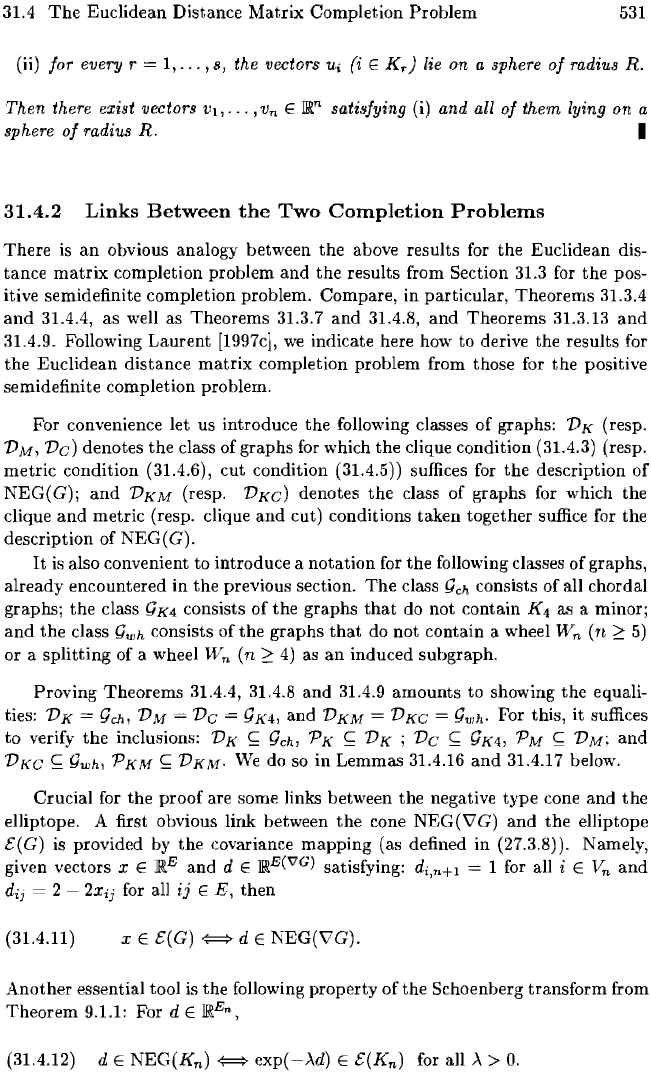
31.4
The
Euclidean Distance Matrix Completion Problem
531
Oi)
for every r = 1,
...
, s, the vectors
Ui
(i E
Kr)
lie on a sphere
of
radius R.
Then there exist vectors
VI,·
••
,
Vn
sphere
of
radius R.
lJin
satisfying (i) and all
of
them lying on a
I
31.4.2
Links
Between
the
Two
Completion
Problems
There
is
an
obvious analogy between the above results
for
the Euclidean dis-
tance
matrix
completion problem and the results from Section 31.3 for the pos-
itive semidefinite completion problem. Compare, in particular, Theorems 31.3.4
and
31.4.4, as well as Theorems 31.3.7
and
31.4.8,
and
Theorems 31.3.13
and
31.4.9. Following Laurent
[1997c],
we
indicate here how to derive the results for
the Euclidean distance
matrix
completion problem from those for the positive
semidefinite completion problem.
For convenience let us introduce the following classes of graphs:
VK
(resp.
V
M
,
Vc)
denotes the class of graphs for which the clique condition (31.4.3) (resp.
metric condition (31.4.6),
cut
condition (31.4.5)) suffices
for
the
description
of
NEG(G);
and
VKM
(resp.
VKC)
denotes
the
class of graphs for which the
clique
and
metric (resp. clique
and
cut) conditions taken together suffice for the
description of NEG(G).
It
is also convenient to introduce a notation for the following classes
of
graphs,
already encountered in the previous section.
The
class 9
c
h
consists of all chordal
graphs; the class
9K4 consists
of
the graphs
that
do not contain
K4
as a minor;
and
the class 9
w
h consists of the graphs
that
do not contain a wheel Wn (n
~
5)
or a splitting of a wheel Wn (n
~
4)
as
an
induced subgraph.
Proving Theorems 31.4.4, 31.4.8
and
31.4.9 amounts to showing the equali-
ties:
VK
9ch,
VM
Vc
9K4, and
VKM
=
VKC
= 9
w
h.
For this, it suffices
to verify
the
inclusions: V
K
~
9ch,
PK
~
VK
;
Vc
~
9K4,
PM
~
VMi
and
VKc
9wh,
PKM
~
VKM·
We
do so in Lemmas 31.4.16
and
31.4.17 below.
Crucial for
the
proof
are some links between the negative type cone
and
the
elliptope. A first obvious link between
the
cone NEG(\7G)
and
the elliptope
fCG) is provided by
the
covariance mapping (as defined in (27.3.8)). Namely,
given vectors x
E
lJiE
and
d E lJiE(\i'G) satisfying:
di,n+l
= 1
for
all i E
Vn
and
dij
2
2Xij
for all
ij
E
then
(31.4.11 )
x E fCG)
dE
NEG(\7G).
Another essential tool is the following property of the Schoenberg transform from
Theorem 9.1.1: For
d E lJiE
n
,
(31.4.12)
dE
NEG(Kn)
~
exp(
-Ad)
E
f(Kn)
for all A >
O.
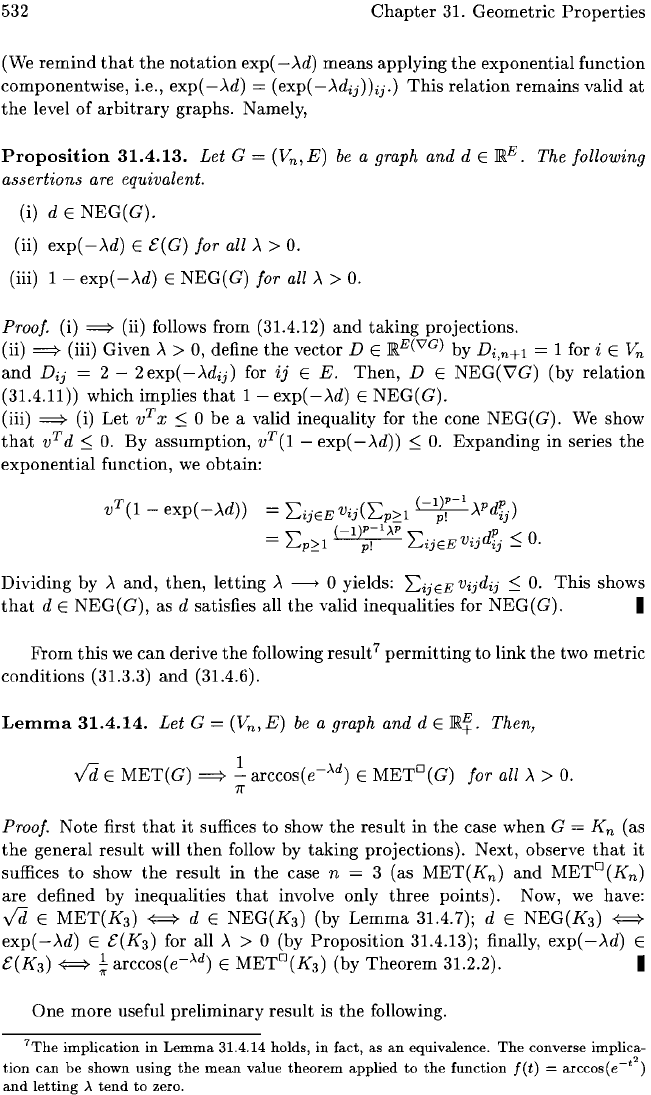
532
Chapter
31. Geometric
Properties
(We
remind
that
the
notation
exp( -
)"d)
means applying
the
exponential function
componentwise, i.e., exp(
-)..d) = (exp( -)..d
ij
) )ij.)
This
relation remains valid
at
the
level
of
arbitrary
graphs. Namely,
Proposition
31.4.13.
Let G = (Vn'
E)
be
a graph and d E
~E.
The following
assertions
are
equivalent.
(i)
dE
NEG(G).
(ii) exp( -)..d) E
e(
G) for all
)..
>
O.
(iii)
1-
exp(-)"d)
E
NEG(G)
for all)" >
O.
Proof. (i)
==}
(ii) follows from (31.4.12)
and
taking
projections.
(ii)
==}
(iii) Given).. >
0,
define
the
vector D E
~E('I7G)
by
Di,n+1
= 1 for i E
Vn
and
Dij = 2 -
2exp(-)..dij)
for
ij
E
E.
Then,
D E
NEG(\7G)
(by
relation
(31.4.11)) which implies
that
1-exp(-)"d)
ENEG(G).
(iii)
==}
(i)
Let
vTx
~
0 be a valid inequality for
the
cone
NEG(G).
We
show
that
v
T
d
~
O.
By
assumption, v
T
(1
- exp( -)..d))
~
O.
Expanding
in
series
the
exponential
function,
we
obtain:
T(1
('d))
-"
.
'("
(_l)p-l
'PdP)
V - exp
-A
-
wijEE
v'J
wp~l
p! A
ij
- "
(_l)p-l>.p"
..
dP
< 0
-
wp~l
p!
wijEE
v'J
ij
- .
Dividing by
)..
and,
then,
letting)..
----->
0 yields:
l:ijEE
Vijdij
~
O.
This
shows
that
dE
NEG(G),
as d satisfies all
the
valid inequalities for
NEG(G).
I
From
this
we
can
derive
the
following result
7
permitting
to link
the
two
metric
conditions (31.3.3)
and
(31.4.6).
Lemma
31.4.14.
Let G = (Vn,
E)
be
a graph and d E
~r
Then,
1
v'd
E
MET(G)
==}
- arccos(e->.d) E METD(G) for all
)..
>
O.
7r
Proof. Note first
that
it
suffices
to
show
the
result in
the
case
when
G =
Kn
(as
the
general result will
then
follow by taking projections). Next, observe
that
it
suffices to show
the
result
in
the
case n = 3 (as
MET(Kn)
and
METD(Kn)
are defined by inequalities
that
involve only
three
points). Now,
we
have:
v'd
E
MET(K3)
~
d E NEG(K3) (by
Lemma
31.4.7); d E NEG(K3)
~
exp( -)..d) E
e(K3)
for all
)..
> 0 (by
Proposition
31.4.13); finally, exp( -)..d) E
e(K3)
~
~
arccos(e->.d) E METD(K3) (by
Theorem
31.2.2). I
One
more
useful preliminary result
is
the
following.
7The
implication
in
Lemma
31.4.14 holds, in
fact,
as
an
equivalence.
The
converse
implica-
tion
can
be
shown
using
the
mean
value
theorem
applied
to
the
function
f(t)
=
arccos(e-t
2
)
and
letting>.
tend
to
zero.
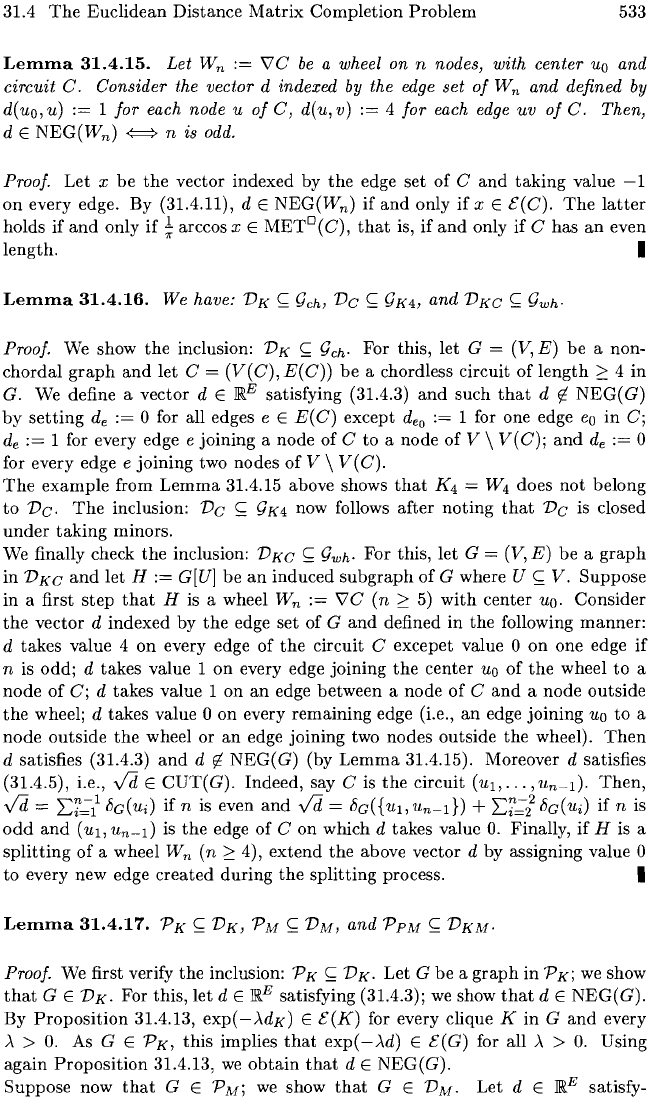
31.4
The
Euclidean
Distance
Matrix
Completion
Problem
533
Lemma
31.4.15.
Let
Wn
:=
\lC
be
a wheel
on
n nodes, with
center
Uo
and
circuit
C.
Consider
the
vector
d
indexed
by
the
edge
set
of
Wn
and
defined by
d(uo,u)
:=
1
for
each node u
of
C,
d(u,v)
:=
4
for
each edge
uv
of
C.
Then,
d E
NEG(Wn)
¢=}
n is odd.
Proof.
Let x be
the
vector indexed by
the
edge set
of
C
and
taking
value
-1
on
every edge. By (31.4.11),
dE
NEG(Wn)
if
and
only
if
x E
£(C).
The
latter
holds if
and
only
if
~
arccos x E METD
(C),
that
is,
if
and
only if C has
an
even
~n~h.
I
Lemma
31.4.16.
We
have:
DK
~
9ch,
Dc
~
9K4,
and
DKC
~
9
w
h'
Proof.
We show
the
inclusion:
DK
~
9
c
h.
For this, let G =
(V,
E)
be a non-
chordal
graph
and
let C =
(V
(C),
E(
C))
be a chord less circuit
of
length
2:
4
in
G. We define a vector d E
RE
satisfying (31.4.3)
and
such
that
d
t/:
NEG(G)
by
setting
de
:=
0 for all edges e E
E(
C)
except
deo
:=
1 for one edge
eo
in
C;
de
:=
1 for every edge e joining a node of C to a node
of
V \
V(
C);
and
de
:=
0
for every edge e joining two nodes
of
V \
V(C).
The
example
from
Lemma
31.4.15 above shows
that
K4
= W
4
does
not
belong
to
Dc.
The
inclusion:
Dc
~
9K4 now follows after
noting
that
Dc
is closed
under
taking
minors.
We finally check
the
inclusion:
DKC
~
9
w
h' For this, let G =
(V,
E)
be
a
graph
in D
KC
and
let H
:=
G[UJ be
an
induced
subgraph
of
G where U
~
V.
Suppose
in a first
step
that
H is a wheel
Wn
:=
\lC
(n
2:
5)
with
center uo. Consider
the
vector d indexed by
the
edge set of G
and
defined
in
the
following
manner:
d takes value 4
on
every edge of
the
circuit C excepet value 0
on
one edge
if
n is odd; d takes value 1
on
every edge joining
the
center
Uo
of
the
wheel
to
a
node
of
C;
d takes value 1
on
an
edge between a node
of
C
and
a node outside
the
wheel; d takes value 0
on
every remaining edge (i.e.,
an
edge joining
Uo
to
a
node
outside
the
wheel or
an
edge joining two nodes outside
the
wheel).
Then
d satisfies (31.4.3)
and
d
t/:
NEG(G)
(by
Lemma
31.4.15). Moreover d satisfies
(31.4.5), i.e.,
v'd
E
CUT(G).
Indeed, say C is
the
circuit
(UI,""
Un-I)'
Then,
v'd
= 2:i,:loc( Ui) if n is even
and
v'd
=
oc(
{Ul'
un-d)
+
2:i~22
oc(
Ui) if n is
odd
and
(UI'
Un-I)
is
the
edge
of
C
on
which d takes value
O.
Finally,
if
H is a
splitting
of
a wheel
Wn
(n
2:
4),
extend
the
above vector d by assigning value 0
to every new edge
created
during
the
splitting process. I
Proof. We first verify
the
inclusion:
PK
~
D K. Let G be a
graph
in
PK;
we
show
that
G E
DK.
For this, let d E
RE
satisfying (31.4.3);
we
show
that
dE
NEG(G).
By
Proposition
31.4.13, exp(
-.\dK)
E
£(K)
for every clique K
in
G
and
every
.\
>
O.
As G E
PK,
this
implies
that
exp(-.\d)
E
£(G)
for all .\ >
O.
Using
again
Proposition
31.4.13,
we
obtain
that
dE
NEG(G).
Suppose now
that
G E
PM;
we
show
that
G E D
M
.
Let d E RE satisfy-
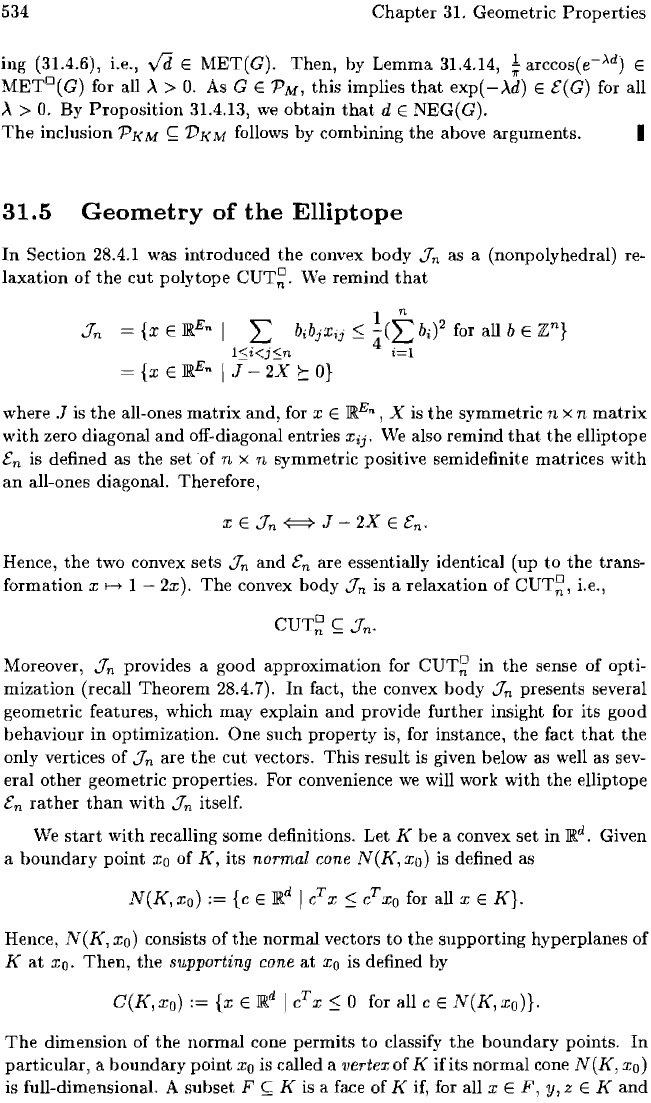
534
Chapter
31.
Geometric Properties
ing (31.4.6), i.e.,
.,fd
E MET(G). Then, by Lemma 31.4.14,
~
arccos(e-.xd) E
METD( G) for all A >
O.
As G E
PM,
this implies
that
exp( -
Ad)
E
e(
G) for all
A>
O.
By Proposition 31.4.13,
we
obtain
that
d E NEG(G).
The
inclusion
PKM
~
DKM
follows by combining the above arguments. I
31.5
Geometry
of
the
Elliptope
In
Section 28.4.1 was introduced the convex body
In
as a (nonpolyhedral) re-
laxation
of
the
cut
polytope
CUT~.
We
remind
that
where
.J
is the all-ones
matrix
and, for x E
JRE
n
,
X is the symmetric n x n
matrix
with
zero diagonal
and
off-diagonal entries
Xij.
We
also remind
that
the elliptope
en
is defined as the set of n x n symmetric positive semidefinite matrices with
an
all-ones diagonal. Therefore,
x E
In
<¢=?
.J
-
2X
E
en.
Hence, the two convex sets In and
en
are essentially identical (up
to
the
trans-
formation
x
1-+
1 -
2x).
The
convex body In is a relaxation of
CUT~,
i.e.,
Moreover,
In provides a good approximation for
CUT~
in the sense of opti-
mization (recall Theorem 28.4.7).
In
fact, the convex body In presents several
geometric features, which may explain and provide further insight
for
its good
behaviour in optimization. One such property is,
for
instance, the fact
that
the
only vertices
of
In
are the cut vectors. This result is given below as well as sev-
eral other geometric properties. For convenience
we
will work with the elliptope
en
rather
than
with
In
itself.
We
start
with
recalling some definitions. Let K be a convex set in
JRd.
Given
a
boundary
point
Xo
of
K,
its normal cone
N(K,
xo)
is
defined as
N(K,xo}
:=
{c
E
JRd
I
S;
c
T
Xo
for
all x E
K}.
Hence,
N(K,xo)
consists
of
the normal vectors to the supporting hyperplanes of
Kat
Xo.
Then,
the supporting cone
at
Xo
is defined
by
C(K,xo)
:=
{x
E
JRd
I
S;
0 for all c E
N(K,xo)}.
The
dimension of the normal cone
permits
to classify the boundary points.
In
particular, a boundary point
Xo
is called a vertex
of
K
ifits
normal cone
N(K,
xo)
is full-dimensionaL A subset F
~
K is a face
of
K
if,
for all x E F, y, z E K and
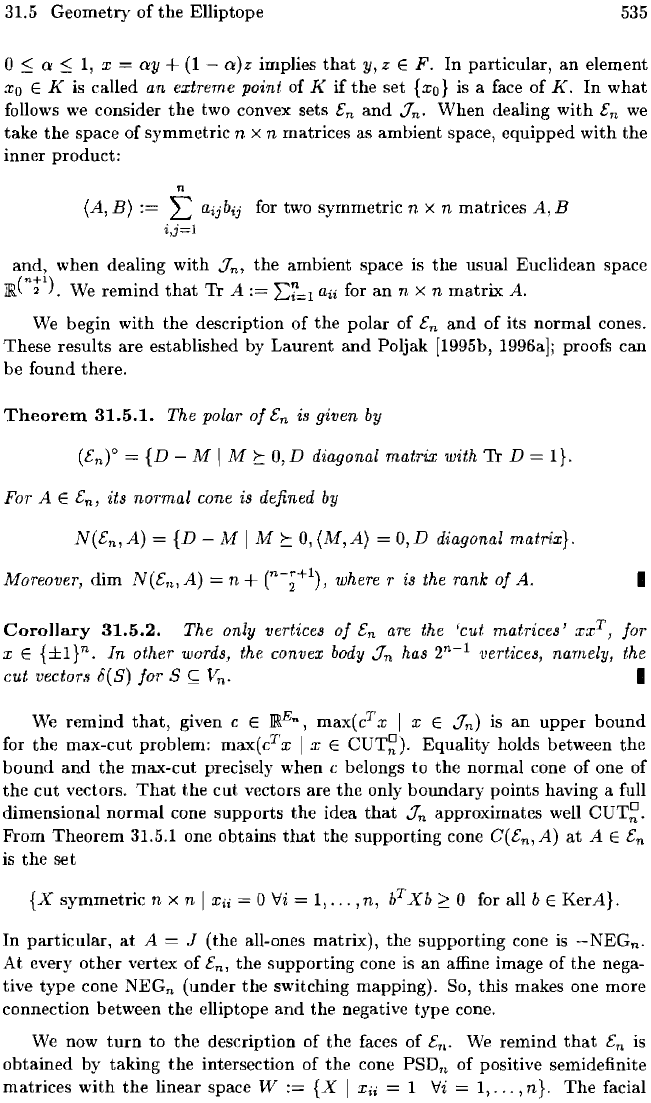
31.5 Geometry
of
the
Elliptope
535
o
::;
a
::;
1,
x =
ay
+
(1
a)z
implies
that
y, z E
F.
In
particular, an element
Xo
E K is called
an
extreme
point of K
if
the set {xo} is a face of
K.
In
what
follows
we
consider
the
two convex sets
En
and
.In. When dealing with
En
we
take
the
space of symmetric n x n matrices as ambient space, equipped with the
inner
product:
n
(A,
B)
:=
2:
aijbij for two symmetric n x n matrices B
i,j""l
and, when dealing with
.l
n
,
the ambient space is the usual Euclidean space
(
"+1)
1R
2 •
We
remind
that
'It
A
:=
l:i=l aii for an n x n
matrix
A.
We
begin with the description of the polar of
En
and
of its normal cones.
These results are established by Laurent
and
Poljak [1995b, 1996aJ; proofs can
be found there.
Theorem
31.5.1.
The polar
of
En
is given by
(Ent
=
{D
- M I M
~
O,D diagonal
matrix
with
'It
D = I}.
For A E En, its
normal
cone is defined by
N(En,A)
=
{D
- M I M
~
0,
(M,A)
= O,D diagonal
matrix}.
Moreover, dim
N(En,
A)
n + (n-;+l), where
l'
is the rank
of
A.
I
Corollary
31.5.2.
The
only
vertices
of
En
are the
'cut
matrices'
xxT,
for
x E
In
other
words, the convex body
.I
n
has 2
n
-
1
vertices,
namely,
the
cut
vectors ti(8)
for
8
I:;::
V
n
.
I
We
remind
that,
given c E
REn,
max( c
T
x I x E .In) is
an
upper
bound
for the max-cut problem: max(c
T
x I x E
CUT~).
Equality holds between
the
bound
and
the
max-cut precisely when c belongs
to
the
normal cone
of
one of
the
cut
vectors.
That
the
cut
vectors are
the
only boundary points having a full
dimensional normal cone supports the idea
that
.I
n
approximates well
CUT~.
From Theorem 31.5.1 one obtains
that
the supporting cone C(En'
A)
at
A E
En
is the set
{Xsymmetricnxnlxii
OVi 1,
...
,n,
b
T
Xb"2::.0 for all
bE
KerA}.
In
particular,
at
A J (the all-ones matrix), the supporting cone is
-NEG
n
.
At every
other
vertex
of
En,
the
supporting cone is an affine image of the nega-
tive
type
cone
NEG
n
(under
the
switching mapping). So, this makes one more
connection between the elliptope
and
the negative type cone.
We
now
turn
to
the
description of the faces of En.
We
remind
that
En
is
obtained by taking the intersection of the cone PSD
n
of positive semidefinite
matrices with
the
linear space W
{X
I Xii 1
Vi
1,
...
,n}.
The
facial
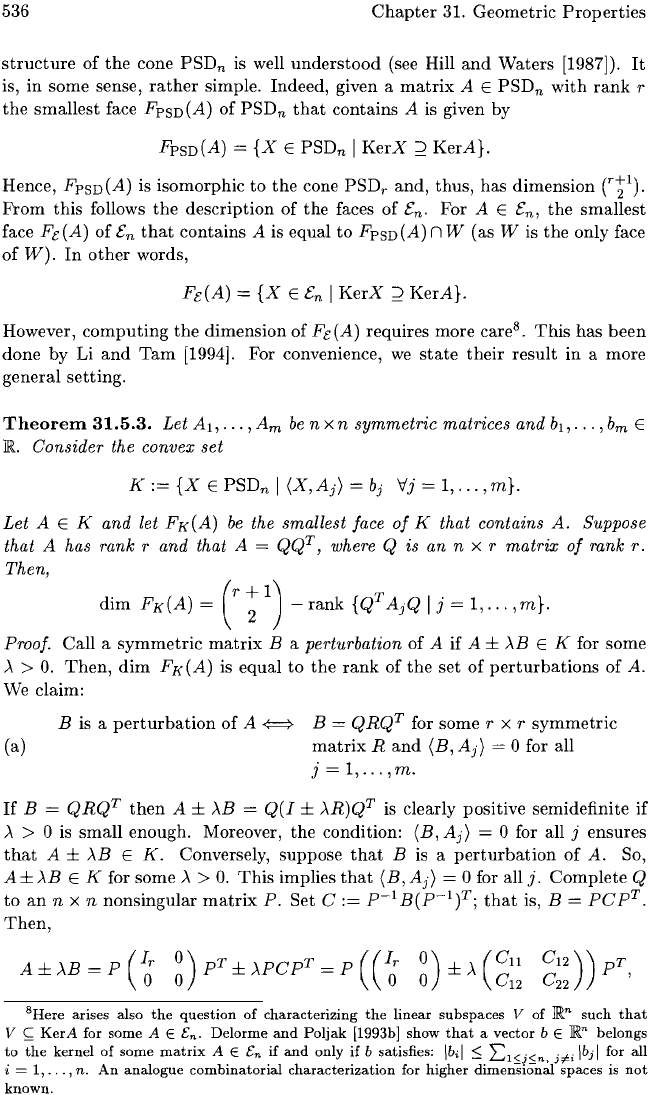
536
Chapter
31. Geometric
Properties
structure
of
the
cone
PSD
n
is well
understood
(see Hill
and
Waters
[1987]).
It
is, in some sense,
rather
simple. Indeed, given a
matrix
A E
PSD
n
with
rank
r
the
smallest
face FpSD(A) of
PSD
n
that
contains A is given by
FpSD(A) =
{X
E
PSD
n
I
KerX
2 KerA}.
Hence,
FpSD(A) is isomorphic
to
the
cone
PSD
r
and,
thus, has
dimension
C!l).
From
this follows
the
description
of
the
faces of
En.
For A E
En,
the
smallest
face
Fe
(A) of
En
that
contains A is equal
to
F
pSD
(A) n W (as W is
the
only face
of
W).
In
other
words,
FdA)
=
{X
E
En
I
KerX
2 KerA}.
However,
computing
the
dimension
of
FdA)
requires more care
8
.
This
has
been
done
by
Li
and
Tam
[1994]. For convenience,
we
state
their
result
in a
more
general
setting.
Theorem
31.5.3.
Let
AI,
.
..
,Am
be
n x n
symmetric
matrices and b
1
, .
..
,b
m
E
R Consider the convex set
K:=
{X
E
PSD
n
I
(X,Aj)
= b
j
Vj = 1,
...
,m}.
Let
A E K and let
FK
(A)
be
the smallest face
of
K that contains
A.
Suppose
that A has rank r and that A
=
QQT,
where Q is an n x r
matrix
of
rank
r.
Then,
dim
FK(A)
=
(r;
1)
_
rank
{QT
AjQ
I j =
1,
...
,m}.
Proof.
Call
a
symmetric
matrix
B a perturbation of A if A ±
)"B
E K for some
)..
>
O.
Then,
dim
FK
(A) is equal
to
the
rank
of
the
set
of
perturbations
of A.
We claim:
B is a
perturbation
of
A
~
B =
QRQT
for some r x r
symmetric
(a)
matrix
Rand
(B,
Aj)
= 0 for all
j =
1,
...
,m.
If
B =
QRQT
then
A ±
)"B
=
Q(I
± )..R)QT is clearly positive semidefinite
if
)..
> 0 is
small
enough. Moreover, the condition: (B,
Aj)
= 0 for all j ensures
that
A ± )"B E
K.
Conversely, suppose
that
B is a
perturbation
of
A.
So,
A±)"B
E K for some).. >
O.
This
implies
that
(B,
A
J
)
= 0 for all
j.
Complete
Q
to
an
n x n nonsingular
matrix
P.
Set
C:=
P-
1
B(P-
1
f;
that
is, B =
PCpT.
Then,
0)
±)..
(C
ll
o C
12
8Here
arises also
the
question
of
characterizing
the
linear
subspaces
V
of
llt
n
such
that
V
<;;
KerA
for
some
A E En.
Delorme
and
Poljak
[1993b]
show
that
a
vector
b E llt
n
belongs
to
the
kernel
of
some
matrix
A E
En
if
and
only if b satisfies:
Ib;j
::;
Ll<j<n,
j'l'i
Ib
j I for all
i = 1,
...
,n.
An
analogue
combinatorial
characterization
for
higher
dimensional
spaces
is
not
known.
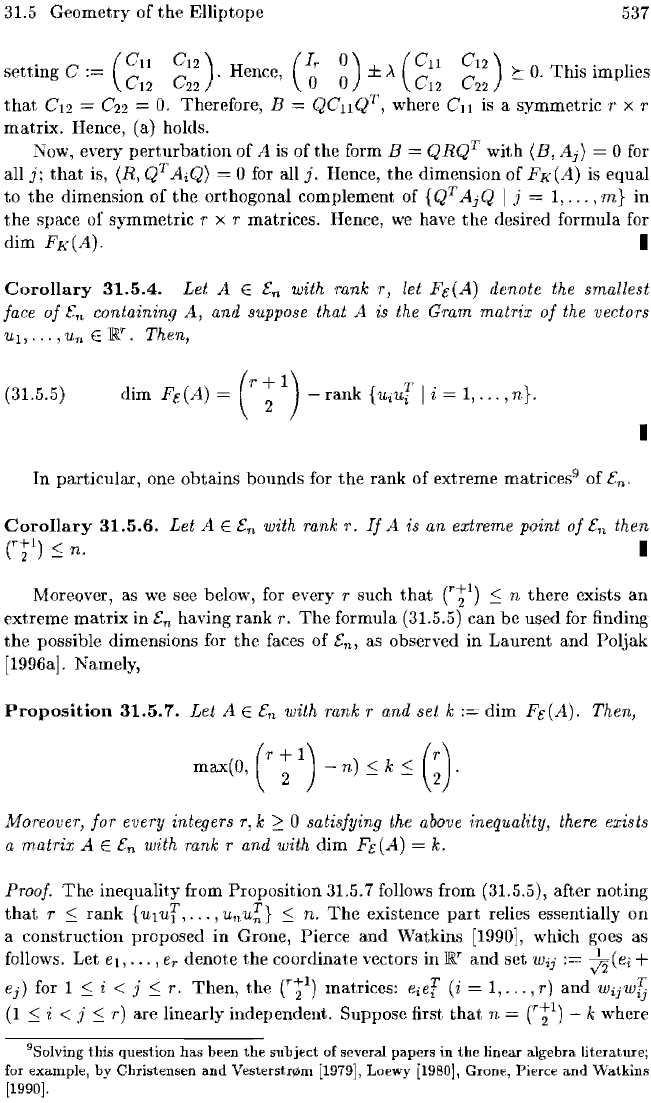
31.5
Geometry
of
the
Elliptope
537
. C
(Cll
Cu)
H
(Ir
0)
,(Cn
C12)
>--
0
Th···
l'
settmg
:=
C12
C22
. ence, 0 0 A
C12
Cn
-'
IS
Imp les
that
C12
=
C22
=
O.
Therefore, B
QCnQT,
where ClI is a symmetric
r'
x r
matrix.
Hence, (a) holds.
~ow,
every
perturbation
of A is of
the
form B QRQT
with
(B,
Aj)
= 0 for
all
j;
that
is, (R, Q1'AiQ) 0 for all
j.
Hence,
the
dimension
of
FK(A)
is equal
to
the
dimension of
the
orthogonal complement of {Q1'
AjQ
I j = 1,
...
,m}
in
the
space of symmetric r x r matrices. Hence,
we
have
the
desired formula for
dim
FK(A).
I
Corollary
31.5.4.
Let A E
t:n
with rank
r,
let Fe(A) denote the smallest
face
of
t:n
containing
A,
and suppose that A is the Gram
matrix
of
the vectors
Ul,""U'"
ERr,
Then,
(31.5.5)
dim Fe(A)
(
r+
1)
2 - rank
{uiuf
I i = 1,
...
, n}.
I
In
particular, one obtains bounds for
the
rank of extreme matrices
9
of
t:n.
Corollary
31.5.6.
Let
A E
t:n
with rank
r.
If
A is
an
extreme point
of
t:n
then
(rtl)
~
n. I
Moreover, as
we
see below, for every r such
that
("tI)
~
n there exists
an
extreme
matrix
in
t:n
having rank r.
The
formula (31.5.5) can
be
used for finding
the
possible dimensions for
the
faces of
t:n,
as observed in Laurent
and
Poljak
[1996aJ. Namely,
Proposition
31.5.7.
Let
A E
t:n
with rank r and
set
k
:=
dim Fe(A). Then,
Moreover,
for
every integers r, k
2::
0 satisfying the above inequality, there exists
a
matrix
A E
t:n
with rank r
and
with
dim
Fe(A) k.
Proof.
The
inequality from Proposition 31.5.7 follows from (31.5.5), after noting
that
r
~
rank
{Ul
ui,
...
,
Un
ur}
~
n.
The
existence
part
relies essentially
on
a construction proposed
in
Grone, Pierce
and
Watkins
[1990J,
which goes as
follows. Let
el,
...
, e
r
denote
the
coordinate vectors in lIr'
and
set
Wij
Ji(
ei
+
ej)
for 1
~
i < j
~
r. Then,
the
(rtl) matrices: (i
1,
...
,r)
and
WijW~
(1
~
i < j
~
'r) are linearly independent. Suppose first
that
n
rtI)
- k where
this
question
has
been
the
subject
of several
papers
in
the
linear
algebra
literature;
for
example,
by
Christensen
and
Vesterstr>,m [1979], Loewy [1980], Grone,
Pierce
and
Watkins
[1990].
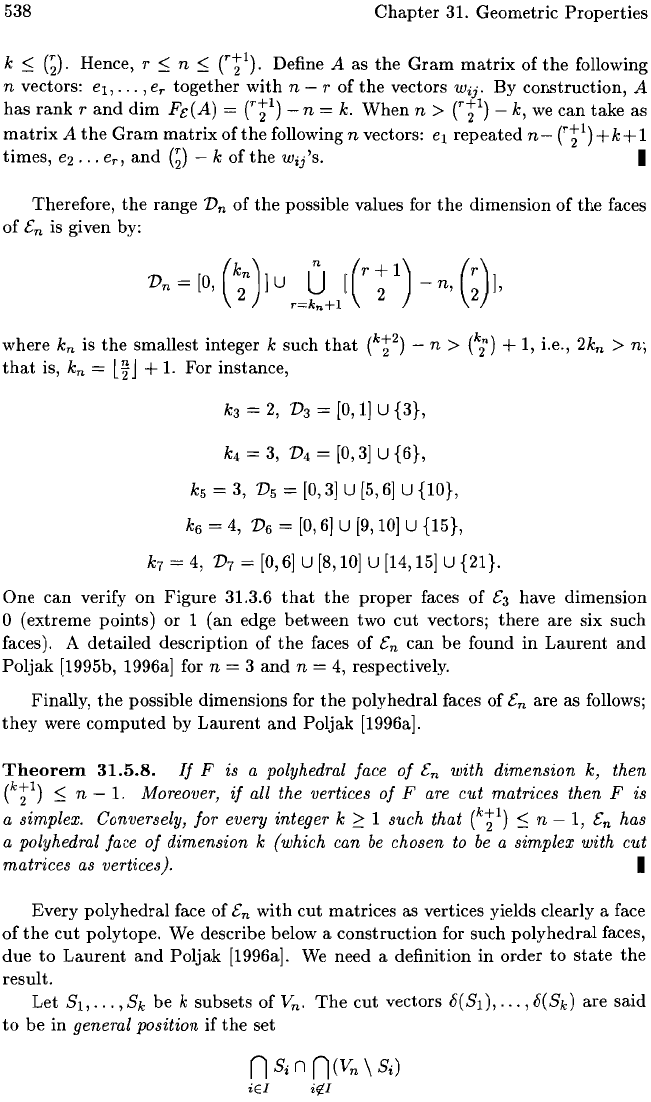
538
Chapter
31. Geometric
Properties
k
~
G).
Hence, r
~
n
~
C!l).
Define A as
the
Gram
matrix
of
the
following
n vectors:
e1,
...
, e
r
together
with
n - r
of
the
vectors
Wij.
By
construction, A
has
rank
r
and
dim
FdA)
=
C!l)
- n =
k.
When
n >
C!l)
-
k,
we
can
take
as
matrix
A
the
Gram
matrix
of
the
following n vectors:
e1
repeated
n-
C!l)
+k+
1
times,
e2
.•.
e
r
,
and
G)
- k
of
the
Wij'S.
I
Therefore,
the
range
Vn
of
the
possible values for
the
dimension
of
the
faces
of
En
is given by:
where
k
n
is
the
smallest integer k such
that
(k!2) - n >
(~n)
+ 1, i.e.,
2k
n
>
n;
that
is, k
n
= l I J +
1.
For instance,
k3
=
2,
V3
=
[0,1]
U
{3},
k4
=
3,
V
4
= [0,3] U {6},
k5
= 3, V5 = [0,3] U [5,6] U {10},
k6
=
4,
V6
= [0,6] U [9,10] U {15},
k7
=
4,
V
7
= [0,6] U [8,10] U [14,15] U {21}.
One
can
verify
on
Figure
31.3.6
that
the
proper
faces
of
E3
have dimension
°
(extreme
points) or 1
(an
edge between two
cut
vectors;
there
are six such
faces). A detailed description of
the
faces
of
En
can be found
in
Laurent
and
Poljak
[1995b, 1996a] for n = 3
and
n =
4,
respectively.
Finally,
the
possible dimensions for
the
polyhedral
faces of
En
are as follows;
they
were
computed
by
Laurent
and
Poljak [1996a].
Theorem
31.5.8.
If
F is a polyhedral face
of
En
with dimension k, then
(kr)
~
n - 1. Moreover,
if
all the vertices
of
F are
cut
matrices then F is
a simplex. Conversely, for every integer k
;::::
1 such that (k!l)
~
n -
1,
En
has
a polyhedral face
of
dimension k (which can
be
chosen
to
be
a simplex with cut
matrices as vertices).
I
Every
polyhedral
face
of
En
with
cut
matrices as vertices yields clearly a face
of
the
cut
polytope. We describe below a
construction
for such
polyhedral
faces,
due
to
Laurent
and
Poljak
[1996a]. We need a definition
in
order
to
state
the
result.
Let
Sl,
...
,
Sk
be k subsets
of
V
n
.
The
cut
vectors O(Sl),
...
,
O(Sk)
are said
to
be in general position
if
the
set
n Si n n
(Vn
\ Si)
iEI
if.!
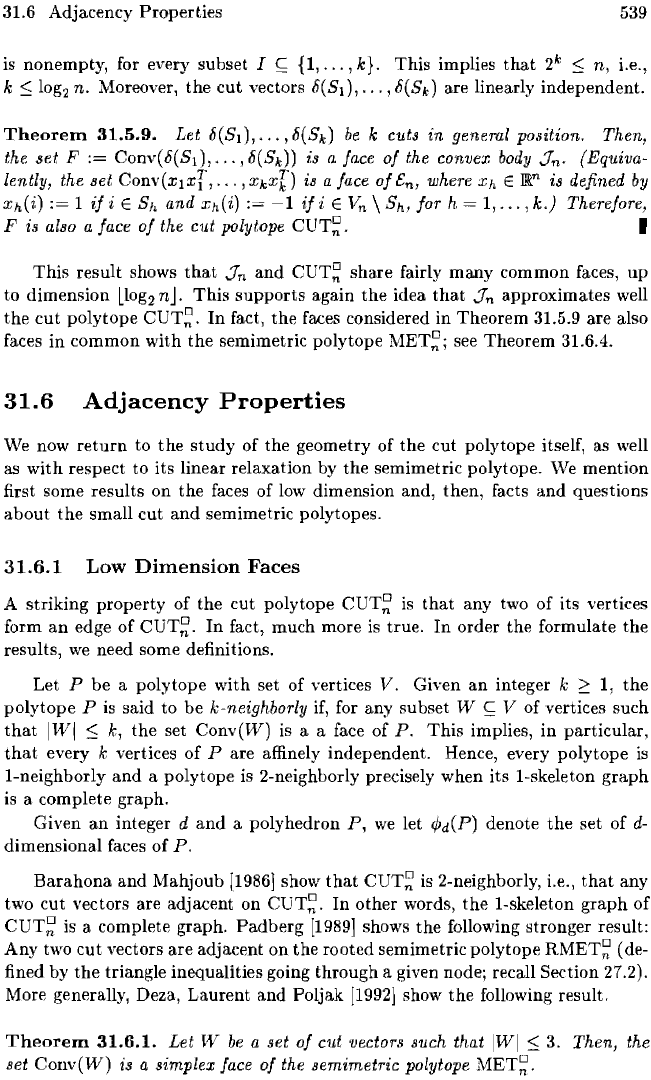
31.6 Adjacency Properties
539
is nonempty, for every subset I
<;;;
{I,
...
,
k}.
This implies
that
2/c
:::;
n, i.e.,
k
:::;
log";!
n. Moreover, the
cut
vectors li(S1)"
..
,li(S/c) are linearly independent.
Theorem
31.5.9.
Let
li(S1),''''
li(S/c)
be
k cuts
in
general position. Then,
the
set
F Conv(8(St),
...
, li(S/c)) is a face
of
the convex
body
In- (Equiva-
lently, the
set
Conv(x1xf,
...
,
x/exf)
is a face
of
en)
where
Xh
E llt
n
is defined
by
xh(i)
1
if
i E Sh
and
xh(i)
-1
if
i E
Vn
\
Sh,
for h = 1,
...
)
k.)
Therefore,
F is also a face
of
the
cut
polytope I
This
result shows
that
In
and
CUT~
share fairly many common faces,
up
to dimension llog2nJ.
This
supports
again
the
idea
that
In
approximates well
the
cut
polytope
CUT~.
In
fact,
the
faces considered
in
Theorem 31.5.9 are also
faces in common with
the
semimetric polytope
MET~;
see Theorem 31.6.4.
31.6
Adjacency
Properties
We
now
return
to
the
study
of
the
geometry of
the
cut
polytope itself, as well
as with respect to its linear relaxation by
the
semimetric polytope. We mention
first some results on the faces of low dimension and, then, facts
and
questions
about
the
small cut
and
semimetric polytopes.
31.6.1
Low
Dimension
Faces
A striking property of the cut polytope
CUT~
is
that
any two
of
its vertices
form
an
edge
of
CUT~.
In
fact, much more is true.
In
order the formulate
the
results,
we
need some definitions.
Let
P be a polytope
with
set of vertices
V.
Given
an
integer k
2:
1,
the
polytope P
is
said to be k-neighborly
if,
for any subset W
<;;;
V of vertices such
that
IWI
:::;
k,
the
set
Conv(W)
is a a face of
P.
This implies, in particular,
that
every k vertices of
Pare
affinely independent. Hence, every polytope
is
I-neighborly
and
a polytope is 2-neighborly precisely when its I-skeleton
graph
is a complete graph.
Given
an
integer d
and
a polyhedron P,
we
let
cPd(P)
denote
the
set of
d-
dimensional faces of
P.
Barahona
and
Mahjoub
[1986]
show
that
CUT~
is 2-neighborly, i.e.,
that
any
two
cut
vectors are adjacent on
CUT~.
In
other words,
the
I-skeleton
graph
of
CUT~
is a complete graph.
Padberg
[19891
shows the following stronger result:
Any two
cut
vectors
are
adjacent on the rooted semimetric polytope
RMET~
(de-
fined by
the
triangle inequalities going through a given node; recall Section 27.2).
More generally, Deza, Laurent
and
Poljak
[1992]
show
the
following result.
Theorem
31.6.1.
Let
W
be
a
set
of
cut vectors such that
IWI
:::;
3. Then, the
set
Conv(W)
is a
simplex
face
of
the
semimetric
polytope
MET~.
